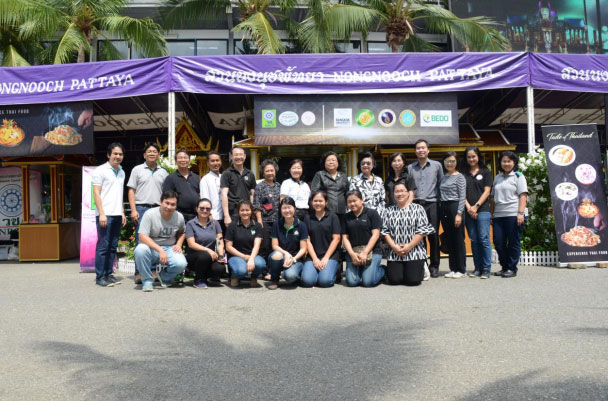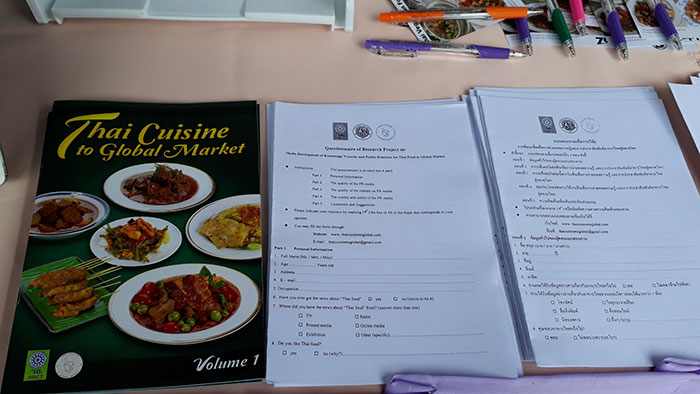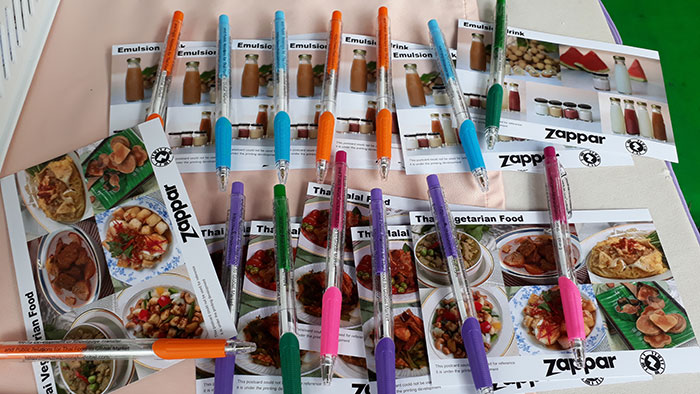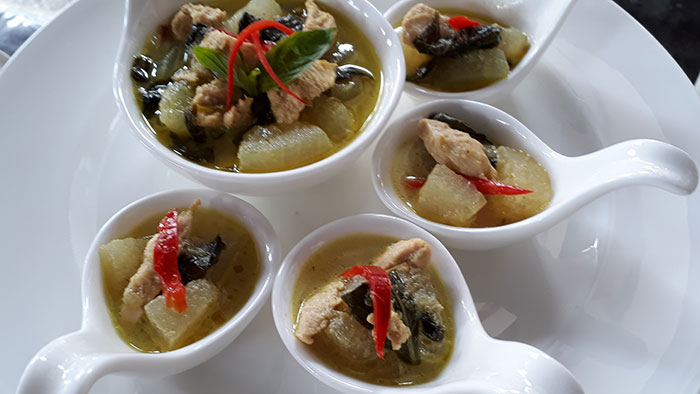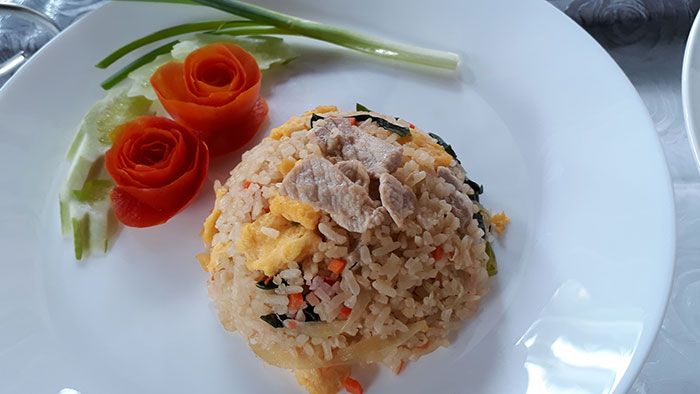Thai Cuisine
to Global Market
About the project

Principal Investigator
Director Associate professor Napavarn NoparatnarapornAn expert in biodiversity Biodiversity-Based Economy Development Office (Public Organization)
The Government Complex Ratthaprasasanabhakti Building, 9th Floor 120, Moo 3 Cheang-Watthana Rd., Thungsonghong Laksi, Bangkok 10210 THAILAND
Tel. 02-141-7807 Fax. 02-143-9202 E-mail: napavarn@bedo.or.th, napavarn.n@gmail.com
Affiliation
Bangkok University, Kluaynamthai Campus 119 Rama 4 Road, Klong-Toey, Bangkok 10110 THAILANDSignificance and Background
The Cabinet meeting on November 17, 2015 has approved a principle of 10 targeted industries as a mechanism to drive economy for the future (New Engine of Growth) as suggested by the Ministry of Industry. Thailand can drive economic growth (S-curve) using 2 methods: First S-curve and New S-curve
Method 1: First S-curveis an investment in current industries in the country to enhance resource efficiency. The First S-curve investment affects a short to medium term economic growth. However, the current industries are not sufficient to promote the leap growth of Thai economy.
The 5 existing industries include:- Next-Generation Automotive
- Smart Electronics
- Affluent, Medical and Wellness Tourism
- Agriculture and Biotechnology
- Food for the Future Method 2: New S-curve is a development of future industries in order to change the format of products and technologies. The new, or future, industry is an important engine that drives the economic growth of Thailand.
The 5 New S-curve industries include:
- Robotics
- Aviation and Logistics
- Biofuels and Biochemicals
- Digital
- Medical Hub
The 10 industries group is a main engine that drives future economy of Thailand. According to study from the Ministry of Finance of the past 10 years, investments in private sectors decrease from 9-10% (in the past) to 2% per year. Information from the Ministy of Industry also indicates only 2% increase of private sector investments within the past 10 years, which slows down the growth of GDP in Thailand, as well as decreases FDI by 6% annually.
Thus, it is critical to expand investment in the private sectors in which a goal of 10% annual increase in investment is set. It will result in 5-6% expansion of GDP. In addition, an enhancement of current industries (First S-curve) is predicted to increase an income of 70%, while a development of new industries is predicted to increase an income of 30% (http://www.cabinet.sco.go.th/).
Thai food has been ranked as one of the top famous cuisine in the world for along time. One of many reasons that makes Thai food well-known in the world market is its unique and mellow taste, together with its health benefits and nutrition provided from Thai seasonings, vegetables, and herbs such as chili, garlic, fingerroot, or cumin.
These herbs are main ingredients in most of Thai curry. Health benefits of Thai food have been revealed by many studies, for example, a study of nutrition and qualitative determination of phytochemical in Thai food. The creation of authentic Thai cuisine project has also shown that Thai food can prevent and lower a risk of developing cancer.
Furthermore, each Thai food menu has its own identity, which can be best for a specific occasion or for a specific person. Due to an increase population of elders around the world, nowadays, many people are concerning about their food and health benefits gained from food. Thus, there is a great opportunity to expand Thai food to global market. The value of Thai food, a benefit of Thai geography, biodiversity of plants in Thailand, and significant food production of Thailand have provided a high market potential for Thai food. Therefore, it is important to develope identity of Thai food to match lifestyle of every person, regardless of social status, age, and nationality. Beside great taste of Thai food, creation and development of Thai food focus on increasing nutrition as well as turning Thai food into healthy food.
According to food business review, Traditional Food has been popular and in trend for more than 10 years, while healthy food trend is increasing recently. Healthy food has been developed for specific health group such as food for people with heart disease, low-fat food, and high-protein products. The most important thing that draws customer’s attention is creative and distinct packaging. Moreover, it is necessary for food producers to concern about society, environments, as well as the global food market in the near future. For example, “Light Diet” and “Better for Your Heart“ trends have recently played an important role in European market with similar percentages of export and import goods.
Thailand is a European market partner as both exporter and importer. Thailand imports seasoning from Europe, while Europe imports ready-to-cook food products from Thailand. European’s consumption lifestyle more concerns about varieties, taste, and naturally appearance of the food. Similarly, the United States and Japan prioritize a word “allergen-free,” which refers back to the basic needs and health concern of the people.
The Market value of Thai food has been predicted to reach 2 trillions baht by 2017, with an expected number of 222 countries, from 6 continents, as partners for Thai food exports. Thailand is considered to be one of the largest food exporters in the world for many products. Furthermore, the Thai Government has also established policy that support developement of Thai food to be competible in the world market.
Although Thai food has provided numerous incomes for the country and its market has fully been supported by the Government, it is very important to promote, introduce, and expand Thai food to the international food market, which consists of various groups of consumers. To make Thai food competible and outstanding in the world market, it is necessary to create differences, to increase values of Thai food, as well as to develope its unique taste based on identity of raw materials in Thailand. In order stabilize Thai food business in the future market, we need to do perform a survey of biodiversity of Thai herbs that help remain original taste of Thai food, and to develop technology for plant breeding and long-term storage of the products. The technology would encourage career building for farmers, as well as provides local plant protection by registration of geographical indicator.
The Thai kitchen to the global market project encourages research integration to create Thai food innovation that is suitable for consumption lifestyle of everybody, and expand it to foreign countries including Europe, United States, Middle-East, and Japan. The project aims to push Thai food products into the international world market and to be competible to others, by creating more varieties food that provide nutrition and health benefits to everybody from child, teenager, people of working age, and elders. Moreover, the product need to be usable or applicable during emergency situation such as flooding and earthquake.
The development is required to present nutritional information, as well as aim to create sustainable Thai food business from upstream (e.g., raw materials), midstream (e.g., technology and food process), and downstream (e.g., promotion and public relations) of the process. Public relations of Thai food includes training, developing media for public relations purposes, and training professional staff to understand authentic Thai food so that they can use the skill for their careers, as well as creating new identity for Thai food.

Objectives
- To promote and support research projects, under the Thai Kitchen to Global Market research program to achieve their individual goals and respond to the Government policy
- To manage operation plan of the research projects to be consistent with research plan required by the National Research Council of Thailand (NRCT)
- To manage research timeline and results of the research projects so that the research projects can achieve their goals within the requirement duration, as well as to facilitate researchers in extend the results to customers and to solve unexpected obstacles during the research operation
- To efficiently manage research grants for achieving the research goals
Operational Plan
The research program focuses on developement of research proposal in collaboration with relevant organizations to meet user and market orientations. The research program directs research project orientations and evaluates scope of study in every processes, as well as to evaluate expected output and manage research grant to be within the allowance of each research project. Moreover, the research program aims to perform public relations of research outcome and encourage research application in private production sectors as well as in industry both domestic and international.
Operational Plan Model

Scope of Work
Research program management is to meet the Government policy on Thai kitchen to global market. The program focuses on research projects that aim to develop and extend the previous research outcomes so that the full utilization of the outcomes can be applied. Moreover, the program considers research projects that emphasize known resources in Thailand and already have market support for exporting of Thai food. Thus, there will be research that can create geographical indicator of raw materials in Thailand in the future. The program will analyse a gap between research project and current market in terms of food for health aspect.


 Research
Research
 Food Videos
Food Videos
 Training
Training
 News
News
 Gallery
Gallery
 Download
Download
 Recipes
Recipes
 Restaurant
Restaurant
 Article
Article
 Webboard
Webboard
 About Us
About Us
 Feedback
Feedback












